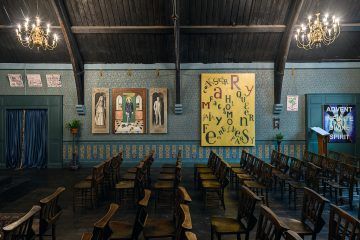Leon Craig in The White Review:
 The light is dim, the air richly scented. Little purple tea lights flicker in the votive candle rack and the walls are decorated with twining sunflowers, exuberant passionflowers and several canvases of blousy green carnations monogrammed with Oscar Wilde’s prisoner ID number C.3.3. The Temple is a deconsecrated church with an attractive dark wood ceiling and matching antique chairs. A half-size marble statue of Wilde presides. The artists, McDermott and McGough, have painted various icons spelling out pejoratives such as ‘pansy’, ‘faggot’ and ‘cocksucker’, adorned with gold leaf and richly-coloured paint. Towards the back are intricate woodcut-style depictions of massacres with titles like ‘Nun Cutting Rope of Dead Homeric’, black canvases with cut-out fatality statistics, and monochrome portraits of individuals more recently killed by homophobia and transphobia, such as Justin Fashanu, Brandon Teena and Marsha P. Johnson. A placard in the hallway spells out all of the bigotries the temple stands against, ending with the instruction ‘only love here’. Opposite is a purpose-built offertory box ‘For the Sons and Daughters of Oscar Wilde’.
The light is dim, the air richly scented. Little purple tea lights flicker in the votive candle rack and the walls are decorated with twining sunflowers, exuberant passionflowers and several canvases of blousy green carnations monogrammed with Oscar Wilde’s prisoner ID number C.3.3. The Temple is a deconsecrated church with an attractive dark wood ceiling and matching antique chairs. A half-size marble statue of Wilde presides. The artists, McDermott and McGough, have painted various icons spelling out pejoratives such as ‘pansy’, ‘faggot’ and ‘cocksucker’, adorned with gold leaf and richly-coloured paint. Towards the back are intricate woodcut-style depictions of massacres with titles like ‘Nun Cutting Rope of Dead Homeric’, black canvases with cut-out fatality statistics, and monochrome portraits of individuals more recently killed by homophobia and transphobia, such as Justin Fashanu, Brandon Teena and Marsha P. Johnson. A placard in the hallway spells out all of the bigotries the temple stands against, ending with the instruction ‘only love here’. Opposite is a purpose-built offertory box ‘For the Sons and Daughters of Oscar Wilde’.
The Temple’s hosts, Studio Voltaire, emphasise its role as a community venue for LGBTQ+ people and their allies. The Temple is open to any members of the public who wish to visit. It is also a venue for LGBTQ+ wedding ceremonies and discussion groups, as well as a mentoring scheme for young people in partnership with the homelessness charity The Albert Kennedy Trust. Wilde’s fame and the high drama of his story – the libel suit he brought against his lover Lord Alfred Douglas’s father for calling him a sodomite, his subsequent prosecution for gross indecency, his miserable years in prison and premature death in exile in France – are instrumentalised by McDermott and McGough as something for everyone to rally around.
More here.
